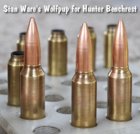dstoenner
Silver $$ Contributor
One of the gifts I asked for Christmas was a box of A-Tips to try out in my 6X47 Lapua. I went to evaluate these new bullets and came up with some surprises. Looking to see what others might have found out for the caliber they are interested in.
Like I do with all of my bullets I take 3 measurements - OAL, base to Ogive and Tip to Ogive of boat tail. I then plug them into my spreadsheet that gives me a range of loaded lengths. The minimum length is based on not letting the ogive go into the case neck. The maximum is based on keeping 1 caliber length of bearing surface in the neck. So the min is 2.453 and the max is 2.732. Next was to measure the length in my chamber to the lands. That was where I got the surprise.
My current barrel has 1944 rounds on it. From a new barrel to now the throat has advanced about .060 on average. My match bullet is either a Berger 105 Hybrid or 115 DTAC. In both cases I have not reached max so I am chasing the lands. And it looks like I will go to the end of the barrel without having to stop chasing the lands if I can get 2500 to 3000 rounds out of this barrel.
BUT the 110 A-Tip measured 2.795 WHAT!!! I measured again and got the same answer within a couple of thousands. I have a new barrel that I just got through breaking in and it has ~250 rounds, so I measured it and came up with 2.735.
I normally start any load development at .020 jump so I am never in danger of pulling a bullet if the line goes cold. No matter how you cut it this bullet will have to jump a whole bunch. My throat for the initial chamber is .104 which I think is sort of middle of the road in length. I would have to go to 0 throat in order to be able to chase the lands to the end of barrel life. I am not for sure what Hornady was thinking when they designed this bullet but for me it seems to be a non starter.
What are any of you guys finding with this bullet in your chambers?
David
Like I do with all of my bullets I take 3 measurements - OAL, base to Ogive and Tip to Ogive of boat tail. I then plug them into my spreadsheet that gives me a range of loaded lengths. The minimum length is based on not letting the ogive go into the case neck. The maximum is based on keeping 1 caliber length of bearing surface in the neck. So the min is 2.453 and the max is 2.732. Next was to measure the length in my chamber to the lands. That was where I got the surprise.
My current barrel has 1944 rounds on it. From a new barrel to now the throat has advanced about .060 on average. My match bullet is either a Berger 105 Hybrid or 115 DTAC. In both cases I have not reached max so I am chasing the lands. And it looks like I will go to the end of the barrel without having to stop chasing the lands if I can get 2500 to 3000 rounds out of this barrel.
BUT the 110 A-Tip measured 2.795 WHAT!!! I measured again and got the same answer within a couple of thousands. I have a new barrel that I just got through breaking in and it has ~250 rounds, so I measured it and came up with 2.735.
I normally start any load development at .020 jump so I am never in danger of pulling a bullet if the line goes cold. No matter how you cut it this bullet will have to jump a whole bunch. My throat for the initial chamber is .104 which I think is sort of middle of the road in length. I would have to go to 0 throat in order to be able to chase the lands to the end of barrel life. I am not for sure what Hornady was thinking when they designed this bullet but for me it seems to be a non starter.
What are any of you guys finding with this bullet in your chambers?
David











